Last weekend, I was in Oregon at a science conference honoring my graduate advisor, Chuck Kimmel. We had science talks, and people gave little speeches, and we had a big ol’ party. One of Chuck’s colleagues and a former advisor of mine, James A. Weston, had something similar some years ago called the JAWFest; we called this one the ChuckFest. Jim told a few stories, and he also recited the intellectual lineage of Charles B. Kimmel, which is an old tradition — like the long recitations of fathers in the Norse sagas, or the begats in the Bible, only this is a chronological list of our educational forebears, and there’s a little less blood and violence.
I got the files from Jim and include it here, which is only fair since it’s also my intellectual pedigree.
Charles B. Kimmel graduated with a Ph.D. from Johns Hopkins, where his advisor was…
James David Ebert (1921 – 2001, PhD, Johns Hopkins, 1950)
As a graduate student with Willier, Ebert worked on the development of the immune system in chicken embryos, and first recognized the Graft vs. Host phenomenon. Ebert took his first job at MIT, and then moved quickly through the academic ranks at Indiana University. In 1956, he was appointed Director of the Dept. of Embryology at the Carnegie Institution of Washington, which was associated with Johns Hopkins University Medical School in Baltimore. During his tenure as Director, the Department became one of the leaders in molecular, and
eventually genetic approaches to studying development. He was closely associated with the MBL, and served as its director from 1970-78. More influential as an administrator than a “bench scientist” Ebert became the self-appointed “matchmaker” of academic jobs in the field of Developmental Biology, and as such, had a huge impact on the field. In the Obiturary written for the SDB in 2001, Don Brown said: “During his career Ebert was President of eight professional societies, trustee of thirteen national and international organizations, and held appointment to some forty different advisory boards and committees of government agencies, and universities. At one time in his career Jim held the presidency or was on the Board of every national and international society concerned with developmental biology. “
Ebert was trained by…
Benjamin Harrison Willier (1890 – 1972; PhD, Chicago, 1921)
When Willier began graduate work at the University of Chicago in 1916, Lillie “assigned” a project to him that eventually led to his dissertation on the development of gonads in Freemartins. Among other things, Willier learned the technique of “benign neglect” for mentoring graduate students from Lillie, which influenced the research trajectories of his 34 doctoral students at the University of Chicago, the University of Rochester, and Johns Hopkins University. These students – especially those trained in his lab at Johns Hopkins – populated the profession of Embryology at almost all the major research universities in U.S. These students, including Clem Markert, John Saunders, J. P. Trinkaus (1948), Jim Ebert (1950), and Irv Konigsberg (1952), among many others, enormously influenced course of Developmental Biology and the lives of several people at this meeting.
Willier was trained by…
Frank Rattray Lillie (1870 – 1947; PhD, Chicago, 1894)
Lillie graduated, in 1891, from the University of Toronto, and spent a summer at the Marine Biological Laboratory (MBL) in Woods Hole, apparently during the first year that Whitman was its Director. He received a fellowship in zoology at Clark University, to study with C. O. Whitman, and in 1892, followed Whitman to the University of Chicago. He was awarded the degree of Doctor of Philosophy in Zoology summa cum laude in 1894. After jobs at the University of Michigan, and Vassar College, he returned to the University of Chicago as an Assistant Professor, and became Professor of Embryology in 1906. In 1908, he succeeded Whitman as Director of MBL and in 1910 took over Whitman’s job as Chairman of the Zoology Department at Chicago. He was interested in the role of sex steroids in sexual differentiation, which set the research path for his student, B. H. Willier.
Lillie was trained by…
Charles Otis Whitman (1842 – 1910; PhD, Leipzig, 1878)
Whitman studied with Leuckart in Leipzig, where he learned the modern methods of microscopy and embryology. He began a “postdoc” at Johns Hopkins in 1879, but was almost immediately recruited by the Japanese government to be Professor at Tokyo Imperial University. In 1883, he moved to the Museum of Comparative Zoology at Harvard, and in 1889, became professor at Clark University in Worcester, Massachusetts. Three years later, he was appointed Professor and Curator of the Zoological Museum at the University of Chicago, while concurrently serving as founding director of the Marine Biological Laboratory in Woods Hole. During his career, he made major contributions in the areas of evolution and embryology, comparative anatomy, heredity, and animal behavior, and in 1887 became founding editor of the Journal of Morphology.
Whitman was trained by…
Karl Georg Friedrich Rudolf Leukart (1822 – 1898; MD, Göttingen, 1845)
Leuckart trained as a comparative morphologist with Wagner in Göttingen. His work led to a new field of animal systematics based on subtle morphological distinctions. He is credited with refining Cuvier’s classification of Radiata into two phyla: Coelenterata and Echinodermata, and dividing the Metazoa into six principal phyla — Coelenterata, Echinodermata, Annelida, Arthropoda, Mollusca, and Vertebrata. One critic of his work declared: “It would have to be considered a good sign for German science if [his book] found no readers.”
Leukart was trained by…
Rudolf Wagner (1805 – 1864; MD, Wurzburg, 1826)
Wagner, an anatomist and physiologist and the co-discoverer of the germinal vesicle, made important contributions on the structure and significance of ganglia, nerve-endings, and the sympathetic nerves. After completing training in medicine and comparative anatomy in Würzburg, he did “postdoctoral” work with Cuvier at the Jardin des Plantes and the Natural History Museum in Paris. He became professor of zoology and comparative anatomy at Erlangen (1832), and took the Professorship in Göttingen in 1840. He died after suffering a stroke while in Bonn studying a Neanderthal skull.
And finally, Wagner was trained by…
Jean Léopold Nicolas Frédéric (Georges) Cuvier (1769 – 1832)
Cuvier, French naturalist and zoologist, first recognized the significance of geological strata and the fossils discovered in them during excavations in Paris, and recognizing the fact of extinction of species. He is particularly recognized for his work in comparative anatomy and vertebrate paleontology and his contributions to: (i) the structure and classification of the Mollusca; (ii) the comparative anatomy and systematic arrangement of the fishes; (iii) fossil mammals and reptiles and, secondarily, the osteology of living forms belonging to the same groups.
Awesome.
Of course, our scholarly ancestors weren’t actually all lined up like that, and each had many scientific progeny, so a lot of people’s history will converge on famous people like Cuvier. Each of us also owes a lot of our understanding to multiple contributors, so in addition to Chuck, I got doled out bits of the brains of Judith Eisen, Monte Westerfield, John Postlethwaite, and even Jim Weston. An accurate rendering of our pedigrees would be more of a rete than a ladder.
But still, I like having some connection to Cuvier…and I’d even known of most of the people on the list. Look at all those developmental biologists!

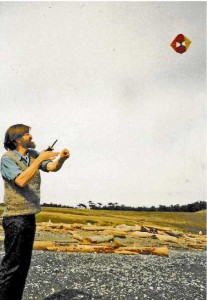
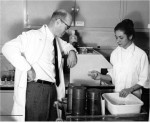
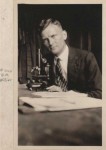
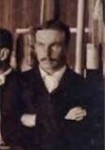
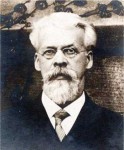
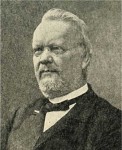
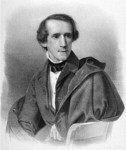
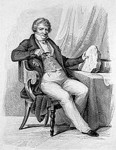

The best part of this was reading how each person contributed (DISCOVERED!) to the body of scientific knowledge. Things we (I) take for granted—of course Vertebrata and Mollusca are separate phyla, and always have been…!—were cutting edge back in the day.
Compare to the boring and useless genealogy of the bibble, where no one did anything except pop out kids (and just the mens, of course):
Hmm.. made me look. The most notable member of my academic lineage would be Leibniz.
The mathematical genealogy project has gotten a lot more data in since I last checked; seems someone went from medicine to math, so I get a bunch of ancestors in biology. The only one I recognize there is Falloppio, and then only because of the tubes.
Mathematicians and computer scientists would recognize a lot of my other pedigree. Jacobi and Hesse stand out for linear algebra stuff, and I bet a few others invented things I use.
An interesting (if mostly pointless) historical exercise!
An exercise that feeds the ego of an academic is never pointless.
I’ve been at a couple of conferences wherein everyone in my subfield put together a lineage. It IS important. From a technical standpoint, it’s good to know what influences each researcher has had, because that can shed light on the way they think, the directions they take or not take, the biases they have in their projects. From a social standpoint, it’s huge. Scientists are people too. It reinforces bonds between labs and thereby helps foster cooperation, it honors and emphasizes the important contributions and contributors to the field, it serves as a way to welcome new scientists into the fold and give them a “place” that links them to everyone else current and who came before. I honestly count it as one of the most emotionally moving experiences I’ve had. And it wasn’t done with fanfare or drama, it was just so… personal.
Did a little checking of my academic pedigree. A bit more international than PZ’s with four countries involved, and two Nobel prize winners just going back to 1900. The breadth of the research is staggering, involving polymers, new reactions, and natural product synthesis that includes steroids and carbohydrates. I salute their efforts.
PZ@3:
Unfortunately it also feeds the imposter syndrome of an academic: I stand on the shoulders of giants … which makes it more obvious how small I am.
OK, my memory was not totally defective. I remembered this linkage:
http://www.usna.edu/Users/math/meh/geneol.html
… and there I bifurcate. But while wikipedia lists Klein as having Story as a student, neither wikipedia nor the AMS list Story as having Klein as an advisor.
Story’s actual thesis is devoid of any acknowledgements, he just sort of dives on in. It’s also devoid of a conclusion or any references — it’s just equations until the last line. I guess academic style has changed over the years.
https://books.google.ca/books?id=cAZBAQAAIAAJ&printsec=frontcover&source=gbs_ge_summary_r&cad=0#v=onepage&q&f=false
Long story short: if you have Klein in your ancestry, you have Leibniz, Euler, Poisson, Dirichlet — and Gauss by another branch. (And Lipschitz, but he is more of a niche celebrity.)
This brought to mind one of my favorite science fiction movies – Enemy Mine.
At the end of the film, the human took on the responsibility of “singing the lineage” of the alien child whom he had adopted.
It would be fun to “sing the lineage” of our favorite scientists.
Just checked, and indeed developmental biologists do have their own equivalent of Neurotree (a ‘family tree’ for neuroscientists, I’m listed in there myself, although it looks like my affiliation needs updating…) If you feel inclined to that sort of thing, you could add your own lineage to DevTree :)
The main site is http://academictree.org/ , if anyone is interested in seeing if their discipline has a genealogy started yet. Far as I know, no sinister motives behind it!
Oops, I think I managed to bork the link to DevTree! It’s http://academictree.org/dev/
…and unfortunately quite a ways down in Google’s search results. Ah well, accessible from the academictree homepage, at least.
awesome post, PZ!
My advisor in materials science was the late Y. Austin Chang, who got his doctorate working for Ralph Hultgren, a long-time collator of thermodynamic data for multicomponent systems of interest. OK, maybe a bit of stamp collecting there, but refining the tools for others to do research is a great work all its own (entirely apart from the skull sweat and expertise required to sort through and determine the accuracy of data reported in the literature).
Ralph Hultgren’s advisor, I am told, was Linus Pauling. Yeah, that’s kind of a nice little present to find in the lineage. Pauling had two advisors, Roscoe Dickinson and Richard Tolman (who determined the mass of the electron, among other things). Dickinson’s lineage is on his Wikipedia page, and if it’s accurate numerobis and I are distantly related through Falloppio (if not someone more recent). Small world!
Perhaps I’m still raw from all the usual bullshit defenders of Tim Hunt, but I don’t like this. It’s slightly better than recitations of fathers and begat begat begats that make it sound like our ancestors reproduced through some sort of parthenogenesis that didn’t require eggs or wombs, and unfortunately our misogynistic history means that for the most part a list like this isn’t going to particularly diverse, but it still doesn’t look good (at least to me).
Yeah, it’s men all the way back, and that tells us something about institutionalized sexism. Even when you look at the history of women in science, you see the same thing: Judith Eisen was a student of Eve Marder at Brandeis, who was a student of Allen Selverston. We’re not going to be seeing pedigrees as biased towards women for a long, long time.
I know the guys that started NeuroTree (and then the larger AcademicTree project); definitely no sinister motives, just nerdy ones.
On the dominance of men in these lineages, it’s interesting to look at Primatology Tree by comparison, which has a slightly more firmly established history of female scientists than many other disciplines.
I find this celebration of academic lineage to be a good thing in the light of all the sexist comments associated with Tim Hunt. It highlights the fact that a scientist’s legacy is not just their discoveries in science but their scientific descendants. The problem with Tim Hunt’s sexist attitude is that it hurts women, but I find it ironic that his attitude also cripples his own legacy to science by cutting off half of his potential scientific “descendants”.